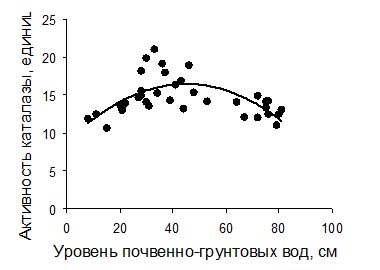Regression models of catalase activity and water regime as criteria for quality assessing of the drained soils of mire pine forests in West Siberia
DOI:
https://doi.org/10.31251/pos.v8i1.297Keywords:
mesotrophic mires; peat soils; regression analysis; evaluation of statistical models; humus state; biogenic elements; stocks and quality of wood.Abstract
The aim of the study was to evaluate the influence of the depth of wetland hydrological reclamation on the quality of forest conditions by assessing statistically the relationship between the catalase activity of drained soils and environmental factors such as mire water levels, volume humidity, biological activity and soil humus status.
Location and time of the study. The southern taiga subzone of West Siberia for three years during May–October.
Methods. As an object for the study, we chose an open mire occupied by a natural pine forest with sphagnum, sedges and shrubs (56°23′ N, 84°34′ E) as the ground cover. The mire was drained 25–30 years ago. The level of ground water, moisture content and catalase activity of the peat soils were studied in seasonal dynamics from May till October with an increment of 5-8 days for three years. At the sites of prevailing surface plant cover of each forest type (sedge+sphagnum, reed grass and herbs+grasses+nettle), pits 0–50 cm were cm, peat monoliths taken, and soil profiles differentiated into 0–5, 5–10, 10–20 and 20–30 cm layers, according to soil colour, density and living roots content. Then the soil from the same depth was bulked to comprise a composite sample. Catalase activity was estimated in fresh soil sample by the permanganate technique.
Results. Excessive desiccation, as well as excessive moisture, reduced the enzymatic activity and soil fertility. Under dehumidification, the highest level of catalase activity was measured, which is a factor contributing to organic matter humification, stable humus formation (humate type), the preservation of biogenic elements reserves and high average annual increases of the high–quality wood.
Conclusions. Highly significant paired regression models based on second-order polynomials were obtained. The models can become the basis for developing techniques for managing the humus state, increasing and maintaining the fertility of peat soils when planning hydrotechnical engineering measures for the rational forestry development of mires.
Downloads

Downloads
Published
How to Cite
Issue
Section
License
Copyright (c) 2025 The Journal of Soils and Environment

This work is licensed under a Creative Commons Attribution 4.0 International License.






